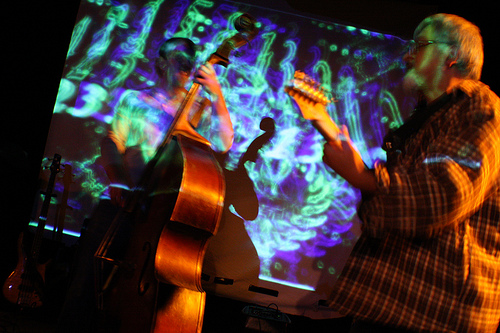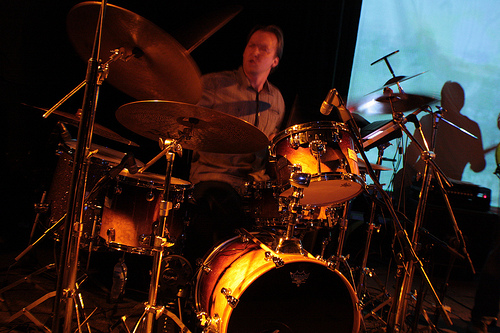
After 10 years as a founding member of the jam-jazz fusion group Garaj Mahal, Fareed Haque has left to explore different musical pastures. In a recent interview, he credited the Moog guitar’s incredible advances in sonic capabilities for driving him in a more electronic direction. But the music isn’t the only part of this new vision that has a severe electronic bent. MathGames has teamed up with projectionist Craig Pessolano to push the envelope of the fusion of sound & sight. With Haque, Alex Austin on electric & acoustic bass, and Greg Fundis on the drumkits, MathGames sets out to create mind-altering soundscapes on which the visual attack of Pessolano can move & swing. The concept is brilliant, but would the live performance live up to the full potential of the artistic vision? This is what I set out to discover on January 29th at Martyr’s in Chicago, Illinois.
I have seen Fareed Haque draw large crowds at multiple venues in the city; he’s built quite a passionate following of appreciative fans. So I expected this Saturday night show to bring out a very strong audience. But when I arrived at Martyr’s I found only about 50 people enjoying the opening act. By the time MathGames hit the stage the population had risen to over 100 people… but not much over. It was a generally disappointing turnout. Nonetheless, the people who were in attendance got the pleasure of watching this band construct its foundation. This was, after all, only their fourth official performance as a group.

They came right out of the gate with Haque on the Moog guitar (his cornerstone instrument for this group) and Austin on the electric bass, an indication that they were very much straying away from the typical jazz arrangement. This is a key point; because despite the heavy electronic presence MathGames brought to the table, they are still very much a jazz group. This strong jazz energy came through in a pair of songs near the beginning of the set. “Snow > Irregular Geometries” obviously focused of Haque’s distinctly nuanced style, which now felt more like that of a Mad Scientist thanks to the sound-mutating abilities of the Moog. But what really came through to me was the acute form of chemistry between the three members that I’ve only ever seen in a jazz club. Fundis’ style on the skins veered from potent to catastrophic based on the movement of the guitar sounds. His eyes almost never broke contact with Fareed, always maintaining a line of vision in order to read the musical force oozing from Haque like sheet music. Austin, on the other hand, seemed to float on the power of the sound itself, massaging his lowtones into the soundscape with a deft touch. “Snow” was indeed a cerebral, fuzzy expanse of sound highlighted by a distorted flurry of string picking. This segued into “Irregular Geometries” which had a completely different feel altogether. This song displayed one of the core visions of this project—for the visual display to mirror the playing on stage. Haque played a series of patterns of notes, two notes, then three, then four, and so on up to seven. The backdrop screen came alive with shapes and numbers corresponding to what his left hand was doing on the neck of the guitar. He repeated the patterns and mixed them up, creating a waterfall of multi-colored numerals. It was cool to see this concept come to life. But musically, it was kind of a dull thing.

The absolute gem of the night was the song “Punjabi Soul.” It began with Haque hammering out an incredible arrangement on his homemade-looking sitar-guitar. Soon he transitioned back to the Moog and laid down desperate, haunting riffs that danced over Austin’s piledriving bass. Fundis was all over this song as well and went ape on his drums, pounding them as if he hated their ugly faces. This was a song that managed to sound wildly complex yet smoothly cohesive at the same time. Indeed, it was the most complete & well-rounded song of the night and my personal favorite. Following this relatively traditional song, they leapt back into some electronic-based material. This section of songs was certainly interesting but I felt like there was something missing. Haque had mentioned in our interview that he was excited about the possibility of having guests appear with them; this statement rang prescient as I soaked in these songs. They sounded alright, but something like a DJ or a psychedelically-distorted trumpet could have taken the jam to the next level. And not to pile on, but these songs were also very much lost on the mostly older crowd. The focus in the room dipped noticeably and crowd chatter crept into my ears like a cold wind.

Luckily the encore song was a very solid version of the Haque classic, “Pat A Cake,” which snapped the crowd back to attention. Fareed absolutely scorched my brain with some incredible banjo-picking while using the Moog guitar. Talk about a wild sound! This picked up steam, building an awesome tension that released into an all-out Moog shredfest. Austin & Fundis kept up their powerful ways, but Haque sped off on his tumbling, relentless scaling and took my ears along for the ride. His style is absolutely unique and you simply have to hear it to understand it… and once you do, you will never forget it.
Overall, this show was impressive in a number of ways; but I’d be lying if I said I was in love with it. What I saw was a group with a very distinct vision in the infancy of their mission to push the boundaries of what is possible with a live music experience. The projection displays from Craig Pessolano were innovative & stimulating, but I think the visuals fell a little short without the aid of additional lighting effects. And the music was absolutely brilliant at times but ultimately lacked the consistency & energy of what I’ve come to expect from Fareed Haque. But that won’t stop me from expecting this group to become great. I anticipate that with some more seasoning they will become the electro-jazz monster that they envision. The roots have taken hold, now it’s time to grow.


No Comments comments associated with this post